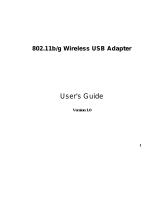
IEEE 802.11b/g Wireless USB 2.0 Adapter Version 2.0
2
Table of Contents
1 INTRODUCTION ....................................................................................................................4
1.1 F
EATURES & BENEFITS..................................................................................................... 4
1.2 P
ACKAGE CONTENTS........................................................................................................ 5
1.3 USB
ADAPTER DESCRIPTION............................................................................................ 5
1.4 S
YSTEM REQUIREMENTS .................................................................................................. 5
1.5 A
PPLICATIONS.................................................................................................................. 6
1.6 N
ETWORK CONFIGURATION............................................................................................... 7
2 INSTALL DRIVERS & CLIENT UTILITY................................................................................ 9
2.1 B
EFORE YOU BEGIN ......................................................................................................... 9
2.2 I
NSTALLING THE DRIVERS.................................................................................................. 9
3 USING THE CLIENT UTILITY.............................................................................................. 15
3.1 C
URRENT STATUS.......................................................................................................... 15
3.2 P
ROFILE MANAGEMENT .................................................................................................. 16
3.2.1 Scan for available networks..................................................................................... 17
3.2.2 Create a New Profile................................................................................................ 18
3.2.3 Security.................................................................................................................... 19
3.2.3.1 Security Disabled............................................................................................ 19
3.2.3.2 WPA / WPA2 – TLS, TTLS ............................................................................. 20
3.2.3.3 WPA / WPA2 – PEAP (EAP-GTC).................................................................. 22
3.2.3.4 WPA / WPA2 – PEAP (EAP-MSCHAP-V2) .................................................... 24
3.2.3.5 WPA / WPA2 – LEAP...................................................................................... 26
3.2.3.6 WPA / WPA2 – Passphrase............................................................................ 27
3.2.3.7 802.1x – TLS, TTLS........................................................................................ 28
3.2.3.8 802.1x – PEAP (EAP-GTC) ............................................................................ 30
3.2.3.9 802.1x – PEAP (EAP-MSCHAP-V2)............................................................... 32
3.2.3.10 802.1x – LEAP................................................................................................ 34
3.2.3.11 Pre-Shared Key (Static WEP)......................................................................... 36
3.2.4 Advanced Settings................................................................................................... 37
3.2.4.1 Infrastructure Settings..................................................................................... 37
3.2.4.2 Ad Hoc Settings .............................................................................................. 38
3.3 D
IAGNOSTICS................................................................................................................. 39
3.4 E
NABLE / DISABLE RADIO................................................................................................ 41
3.5 D
ISABLE TRAY ICON........................................................................................................ 43
3.6 D
ISPLAY SETTINGS......................................................................................................... 43
4 UNINSTALL THE DRIVERS & CLIENT UTILITY................................................................ 45
APPENDIX A – SPECIFICATIONS............................................................................................... 47
APPENDIX B – FCC INTERFERENCE STATEMENT ................................................................. 48




















